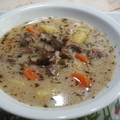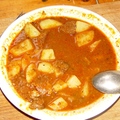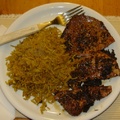|
Taste Test
These seasonings are listed according to how they scored in my taste test, with the top-scoring seasoning listed first. Prices may vary, depending on the store.
Chef Paul Prudhomme’s Blackened Redfish Magic 2 ounces, $4.29 Ingredients: Salt, spices, dehydrated garlic, paprika and dehydrated onion. Sodium: 95 mg (4 percent recommended Daily Value, based on a 2,000-calorie diet) in 1/4 teaspoon.
Cajun’s Choice Creole Seasoning 3.8 ounces, $2.99. Ingredients: Salt, red, black, white peppers, garlic, other spices. No MSG. Sodium: 200 mg (8 percent DV) in 1/4 teaspoon.
McCormick Perfect Pinch Cajun 3.18 ounces, $3.49. Ingredients: Salt, spices (including red pepper, black pepper, thyme and celery seed), paprika, garlic and onion. No MSG. Sodium: 130 mg (about 5.5 percent DV) in 1/4 teaspoon.
Cajun’s Choice Blackened Seasoning 2.75 ounces, $2.99 Ingredients: All natural spices (including paprika, red, black white peppers, oregano), salt, onion and garlic. No MSG. Sodium: 90 mg (4 percent DV) in 1/4 teaspoon.
Luzianne Cajun Seasoning 8 ounces, $2.79. Ingredients: Salt, spices, hydrolized soy protein (soy protein, partially hydrogenated cottonseed and soybean oil), paprika, monosodium glutamate, garlic, corn syrup solids, lemon juice and lemon oil. Sodium: 260 mg (11 percent DV) in 1/4 teaspoon.
Emeril’s Original Essence 2.8 ounces, $4.15 Ingredients: Salt, paprika, black pepper, granulated garlic, spices, onion powder. Sodium: 135 mg (about 5.5 percent DV) in 1/4 teaspoon.
Zatarain’s Creole Seasoning 8 ounces, $1.99. Ingredients: Salt, dextrose, garlic, chili powder, cayenne pepper, sugar, paprika, black pepper, onion, spices, natural flavors, silicon dioxide (flow agent), disodium inosinate, disodium guanylate (flavor enhancer). Sodium: 270 mg (11 percent DV) in 1/4 teaspoon.
Tony Cachere’s Original Creole Seasoning 8 ounces, $2.29. Ingredients: Salt, red pepper, black pepper, chili powder (chili pepper, spices, salt, garlic powder), garlic, silicon dioxide (to prevent caking). Sodium: 350 mg (15 percent DV) in 1/4 teaspoon.
|
I’ve been cooking a lot of Louisiana dishes lately, and it has given me the opportunity to taste several different Creole seasonings.
Creole seasoning is a blend of three peppers — white, black and cayenne — and other spices and herbs. Typically, the peppers are mixed with salt, paprika, thyme and oregano. The blend usually contains garlic powder and often onion powder. Some blends use some chili powder, too.
I first encountered Creole seasoning in the 1980s when I was cooking in restaurants. Blackened redfish had just caught on across the country. My colleagues and I called the blend “blackened seasoning,” as it still is often called today.
Despite the name, the same seasoning seems to be used by Creole and Cajun cooks. The same or similar blend sometimes can be called Cajun seasoning, and at least one brand of “Creole” seasoning is made by a company with “Cajun” in the name.
In the 1980s, I don’t remember that stores even carried pre-mixed blends. Cajun and Creole cuisines weren’t mainstream.
I made my own seasoning blend, using a recipe from the creator of blackened redfish, the one and only Paul Prudhomme.
Making the blend takes just a minute or two if you have the components.
Perhaps out of laziness, I stopped making my own. But I started thinking about it recently because I tried several brands, and not all of them were good.
I’d describe the worst as salty and nondescript. Some just didn’t taste like anything. And if they have no taste, why bother using them?
So I gathered all of the major brands and put them to a taste test.
The ingredients vary substantially. In addition to the standard ingredients, some of these contain sugar, (dehydrated) lemon juice and lemon oil, and soy protein. A couple of them contain monosodium glutamate (MSG). A couple also use silicon dioxide to prevent caking.
Most list salt as the first and largest ingredient.
Those highest in sodium are Tony Cachere’s Original Creole Seasoning, at 15 percent of the recommended Daily Value for a 2,000-calorie diet, followed by Zatarain’s Creole Seasoning and Luzianne’s Cajun Seasoning, both with 11 percent DV sodium.
On the low end of the sodium spectrum are Chef Paul Prudhomme’s Blackened Redfish Magic and Cajun’s Choice Blackened Seasoning, both with about 4 percent DV; and Emeril’s Original Essence and McCormick Perfect Pinch Cajun, both with about 5.5 percent DV.
Prudhomme also makes a line of salt-free Magic Seasoning blends, but I did not include any in the test because testing a salt-free blend next to a salted blend isn’t a fair comparison.
Unfortunately, labeling laws are not strict for spice blends. Some of these blends vaguely list “spices” or “natural flavors,” so it’s hard to know exactly what is in them, or to compare the contents to other brands.
Comparison, then, rests mostly on taste.
I assembled a semi-expert tasting panel (i.e. my family) to taste eight store-bought blends. I was the only one who knew which was which.
I chose only those seasonings that I found in local stores, and gathered eight jars. Several were labeled “Creole seasoning,” two were labeled “Blackened” and two were labeled “Cajun.”
In only one instance did I choose two made by the same company. I tested Cajun’s Choice Creole seasoning and Cajun’s Choice Blackened Seasoning, mainly to see if I could discern anything specific that earned the term “blackened.” I couldn’t, so as far as I can tell, if a seasoning is labeled “blackened,” it’s still Creole seasoning.
Prudhomme’s Blackened Redfish Magic got the top scores in the tasting. This blend has lots of peppery oomph, but it is also well-balanced and very flavorful.
The Magic seasoning scored only slightly higher than Cajun’s Choice Creole Seasoning and McCormick’s Perfect Pinch Cajun, which tied for second place. McCormick’s is a little unusual — and maybe that’s why it’s called Cajun and not Creole — in that in contains celery seed. But it has a good garlic and herb flavor; it also has a noticeable cayenne kick.
Cajun’s Choice Creole Seasoning is a good, all-around blend, with all the elements well represented.
At the bottom of the list is Tony Cachere’s Original Creole Seasoning, which tasted of salt and little else. Second from the bottom was Zatarain’s Creole Seasoning, which didn’t have much flavor.
Scoring in the middle were Emeril’s Original Essence, which I liked more than other family members, and Cajun’s Choice Blackened Seasoning and Luzianne Creole Seasoning.
Luzianne — the only other blend besides McCormick’s that is labeled Cajun instead of Creole — had the longest ingredient list, including such unusual additions as lemon oil, hydrolyzed soy protein and corn-syrup solids. It’s also the only brand that named MSG in its ingredient list. Luzianne’s taste reminded me more of Old Bay than Creole seasoning.
A few trends did emerge from the tasting. High-sodium content generally translated into less flavor and lower scores. Shorter ingredient lists generally meant better flavor and higher scores.
Also, it appears that you get what you pay for. The highest-scoring blend were the most expensive per ounce; the two low scorers were the cheapest.
If I had to choose a best value, I would choose Cajun’s Choice Creole Seasoning.
Of course, the real value is probably the blend that you make in your own kitchen. Assuming you normally buy all the components to keep in your cupboard for other uses, it almost certainly will come out cheaper.
Here’s an all-purpose recipe that I put together. You may want to adjust the proportions to suit your tastes, but this blend has all the essential elements and a good balance of peppers, herbs, garlic and onion.
Creole Seasoning
- 1/2 teaspoon dried thyme
- 1/2 teaspoon dried oregano
- 1 tablespoon sweet paprika
- 1 tablespoon salt
- 1 teaspoon ground black pepper
- 1 teaspoon ground white pepper
- 1 teaspoon cayenne pepper
- 1 teaspoon garlic powder
- 1 teaspoon onion powder
Rub the thyme and oregano between your fingers or palms to powderize, then mix with remaining ingredients. Store in an airtight container.
|







